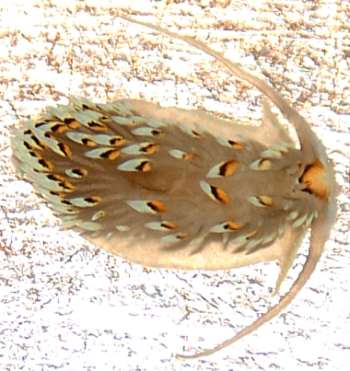
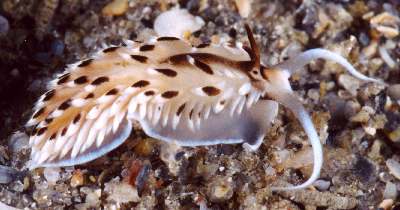
Cerberilla tanna
Marcus & Marcus, 1960
Order: NUDIBRANCHIA
Suborder: AEOLIDINA
Family: Aeolidiidae
DISTRIBUTION
Caribbean
PHOTO
Upper Photo: Apalachicola Bay, NW Florida, USA. 2.6 and 4.1 m, in sand. January, 2004. 15-20mm long. Photo: Kelly Hooper.
Lower Photo: West Palm Beach, Florida, USA, Depth: 15 feet. May 4, 2003. Photo: Linda Ianello
NOTE: This identification is tentative - see discussion below.
Cerberilla tanna was described from preserved material collected off Sabine Jetties, Texas, USA. Size 25mm long preserved. The colour of the preserved specimen was described as "dirty yellow with an orange-brown spot on the outer surface of many, not all, cerata under the cnidosac." Marcus & Marcus state that "The radula is the best character for the distinction of the new species ...." . This is therefore another of the Marcus's problematic species from the Caribbean. To my knowledge this is the only species of Cerberilla reported from that region. The photos alongside from Florida are possibly this species, the brownish one representing a juvenile colour form.
Reference:
• Marcus, E. and E. Marcus. 1960. Some opisthobranchs from the northwestern Gulf of Mexico. Publications of the Institute of Marine Sciences, University of Texas, 6: 251-264. [Stated date: 1959.]
Rudman, W.B., 2003 (May 4) Cerberilla tanna Marcus & Marcus, 1960. [In] Sea Slug Forum. Australian Museum, Sydney. Available from http://www.seaslugforum.net/find/cerbtann
Related messages
Cerberilla tanna? from St. Vincent
October 20, 2005
From: Les Wilk
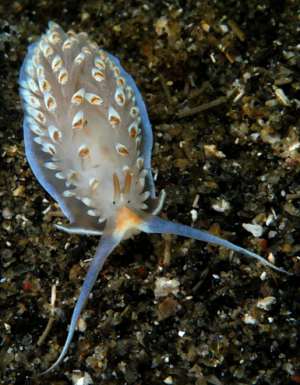
Hi Bill;
Is this a Cerberilla tanna? It was first seen half-buried in the sand, with its tail sticking out. There was another one like it about 5 ft away.
Locality: west coast of St. Vincent Is., Caribbean Sea. Depth: 20 feet. Length: 1 inch. July 2005. sandy bottom. Photographer: Keri Wilk
Les Wilk
wilk@reefnet.ca
Wilk, L., 2005 (Oct 20) Cerberilla tanna? from St. Vincent. [Message in] Sea Slug Forum. Australian Museum, Sydney. Available from http://www.seaslugforum.net/find/15047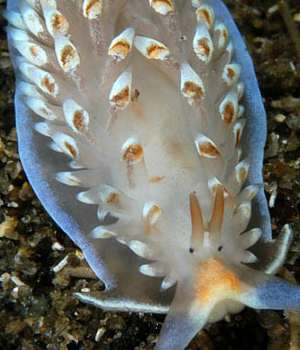
Dear Les,
I am pretty sure this is C. tanna. Usually in Cerberilla, only juveniles have proportionally large oral tentacles, but from other photos we have on the Forum, large oral tentacles appear to persist in adults as well. Your animal doesn't have the distinctive yellow and black bands on the cerata, but there are dark brown and yellowish bands which I assume represent them. Species of Cerberilla are not commonly seen, because of their burrowing life, but I suspect they are probably more abundant than we think.
Best wishes,
Bill Rudman
Cerberilla tanna from Florida
October 7, 2005
From: Howard Beadle
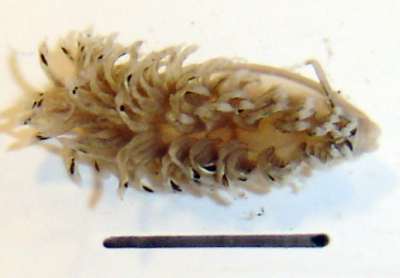
We are trying to find out the name for this little guy.
Locality: Sebastian Inlet, Florida, USA. Depth: 2 meters. Inlet/Estuary. Length: 1.5 cm. 01 October 2005. Otter Trawl. Photographer: Darlene Snider. Scale bar = 1 cm.
Howard Beadle
beadleh@doacs.state.fl.us
Beadle, H.A., 2005 (Oct 7) Cerberilla tanna from Florida . [Message in] Sea Slug Forum. Australian Museum, Sydney. Available from http://www.seaslugforum.net/find/14930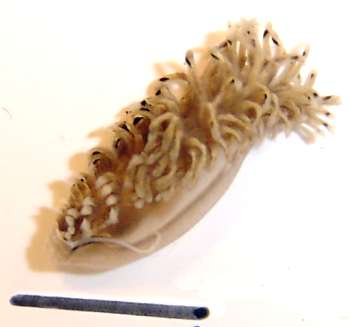
Dear Howard,
This is a rather sick looking Cerberilla tanna. The more specimens I see the more confident I feel about my identification. The species of the the genus Cerberilla are rather unique amongst the aeolid in spending most of their life burrowing in soft sediments, where they apparently feed on sea anemones.
Best wishes,
Bill Rudman
Cerberilla tanna from Mississippi, USA
May 23, 2005
From: Harriet M. Perry
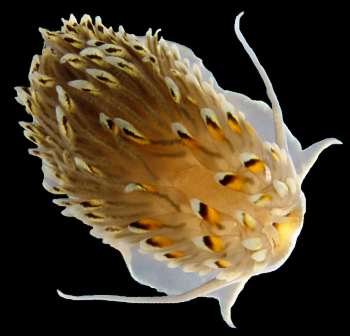
Can anyone identify this sea slug ?
Locality: Mississippi Sound, Mississippi, USA, Gulf of Mexico. Depth: on surface.18 May 2005. Photographer: Harriet M. Perry
Harriet M. Perry
harriet.perry@usm.edu
Perry, Harriet, 2005 (May 23) Cerberilla tanna from Mississippi, USA. [Message in] Sea Slug Forum. Australian Museum, Sydney. Available from http://www.seaslugforum.net/find/13843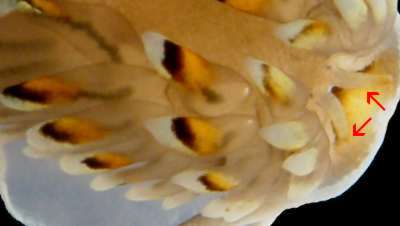
Dear Harriet,
This is almost certainly Cerberilla tanna. Have a look at the Fact Sheet and other attached messages. This is an interesting find as we know very little about this species and other species of Cerberilla from the Caribbean, Until we build up more information it is not possible to be sure just how variable in colour these species are. It would be nice to have some information on its size, if at all possible.
I have added a close-up of the head end to show the rows of cerata, and the brown digestive gland duct which runs up the centre of each ceras. I have arrowed the very short rhinophores, which are quite typical of the genus.
Best wishes,
Bill Rudman
Cerberilla tanna? from Pacific coast of Mexico
February 17, 2004
From: Alicia Hermosillo
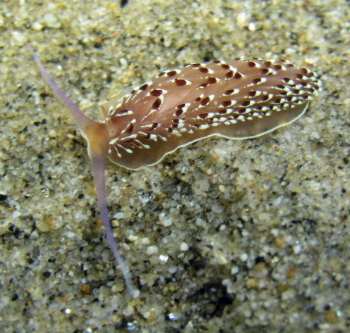
Hi everyone!
I thought this was very interesting. I am not sure if it is indeed the same species, but I found this Cerberilla in Bahia de Banderas, Pacific Coast of Mexico, during a night dive in a muddy bottom. It looks very like C. tanna
Picture info: January 13th, 2004 30 feet deep at La Cruz de Huanacaxtle, Bahia de Banderas
Best wishes
Alicia Hermosillo
gueri25@hotmail.com
Hermosillo, A., 2004 (Feb 17) Cerberilla tanna? from Pacific coast of Mexico. [Message in] Sea Slug Forum. Australian Museum, Sydney. Available from http://www.seaslugforum.net/find/12217Dear Ali,
Dave Behrens told me you had a Cerberilla 'look alike' from the Pacific coast of Mexico. It certainly looks very like Linda Ianniello's photo of what I guess is a juvenile [#9868] so it is possible it is another of those species which are found on both sides of the Panama Isthmus. The problem at this stage is that quite a few species of Cerberilla seem to have this drab brown appearance as juveniles only developing their brighter colours as they grow. One difference is that in Cerberilla tanna there is a black tranverse band in front of the eyes and rhinophores, and in front of that a yellow patch. Your animal doesn't show those colours. I guess only time - and some more animals - will tell
Best wishes
Bill Rudman
Cerberilla tanna from Gulf of Mexico
February 11, 2004
From: Kelly Hooper

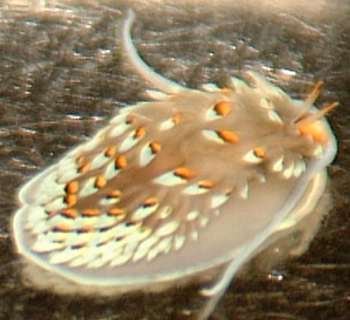
I am not sure if you will be able to help me but I work with a fisheries monitoring program in NW Florida and lately we caught a few nudibranchs that I have been unable to identify. They were caught in trawls at depths between 2.6 and 4.1 m. The bottom in this area I believe is sand. Species were caught on Jan. 8 and Jan. 12, 2004. The area is the Apalachicola Bay, an estuary protected by barrier islands. I have pictures of two species.
I think this one is a species of Cerberilla. It was between 15 and 20 mm. long. Let me know if you have any other questions.
Thanks,
Kelly Hooper
kelly.hooper@fwc.state.fl.us
Hooper. K., 2004 (Feb 11) Cerberilla tanna from Gulf of Mexico. [Message in] Sea Slug Forum. Australian Museum, Sydney. Available from http://www.seaslugforum.net/find/12080Dear Kelly,
This is a species of Cerberilla and I am pretty sure it is the species named by Marcus as Cerberilla tanna. We have some doubts over the identity of that species because the original description was based on a preserved animal so fitting that description to a live animal is going to be problematic. At the moment we have two species of Cerberilla reported from the Caribbean and one name [see earlier messages #9877, #9858, #9868].
I think your animal and Linda Ianiello's [#9868] are the same species. There is the start of a yellow patch in fromt of the rhinophores, and there is an opaque white border to the foot as in your animal. This species best fits the description of the preserved specimen of Cerberilla tanna - "dirty yellow with an orange-brown spot on the outer surface of many, not all, cerata under the cnidosac."
The blue species [#9858] is most probably a distinct, and unnamed species. I will move it to a separate page as Cerberilla sp. 7.
Best wishes
Bill Rudman
Cerberilla tanna? From Florida (2)
May 6, 2003
From: Linda Ianniello

Dr. Bill,
Anne DuPont recently sent you a message from Jeff Hutchinson about a Cerberilla he found last week. We dove the same site last night [4 May 2003] and found another one, but with different coloration. I suspect it is a color variation of Jeff's one, though not as colorful. I checked all the ones I could find on the web and can't find a match. Interesting, it has the identical dark spot at the base of the rhinophores - an eye spot?
Linda Ianniello
lindai@us.ibm.com
Ianello, L., 2003 (May 6) Cerberilla tanna? From Florida (2). [Message in] Sea Slug Forum. Australian Museum, Sydney. Available from http://www.seaslugforum.net/find/9868Dear Linda,
Since this find is very special, and I am also posting a message of another Cerberilla from the Mediterranean, I'm sure no-one will mind me fast-tracking your message to the top of the queue.
You don't give me any indication of size, but I guess from your message this was smaller than Jeff's animal. As you found this at the same place and essentially the same time, I would agree that this probably is a juvenile of Jeff's species. Unfortunately we know very little about the biology of any species Cerberilla so I can't say whether other species have a dull juvenile colour form. Certainly C. incola does, but in C. affinis and C. annulata the main difference seems to be that the juveniles have proportionally much longer oral tentacles.
As I said to Jeff, this is a very interesting find - and yes the dot at the base of the rhinophores is the eye.
Best wishes,
Bill Rudman
